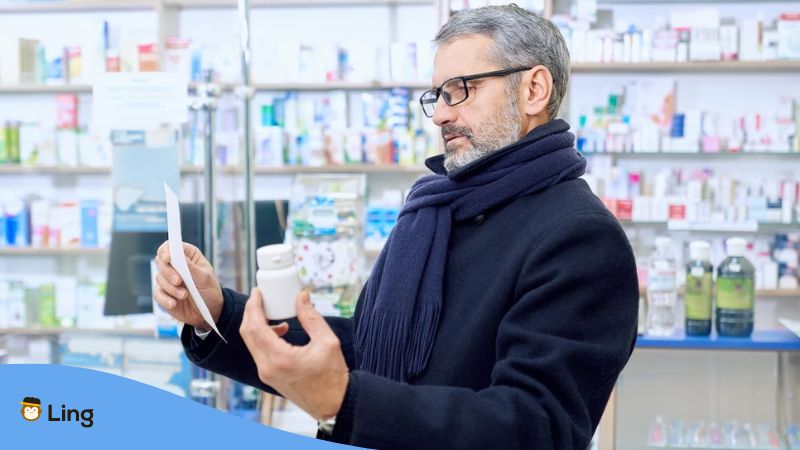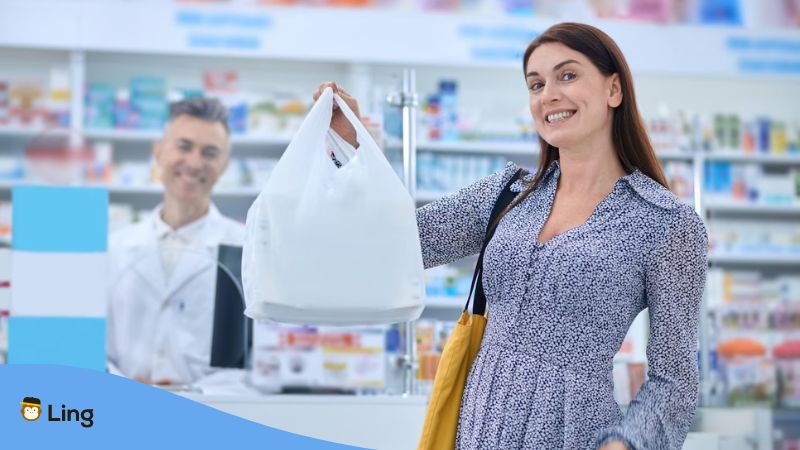Have you ever needed to buy medicine in the Philippines but were unsure how to communicate in Tagalog? Fret not because you’re in the right place! In this post, we’ll guide you on how to buy medicine in Tagalog. Yes, even if you’re starting to learn the Filipino language.
So, why is it important to learn Tagalog phrases for buying medicine? Well, imagine being in the Philippines, facing public health concerns, and feeling under the weather. Your first instinct might be to head to the nearest pharmacy. But what if you can’t find, or worse, can’t communicate what you need? That’s where this article comes in handy.
This guide includes vital vocabulary, useful phrases, and tips for a successful pharmacy visit. Let’s get started!
Basic Tagalog Vocabulary For Buying Medicine
Alright! Before we jump into buying medicine in Tagalog, let’s start by building our vocabulary.
Familiarizing yourself with commonly used Tagalog nouns, verbs, and adjectives in this context is essential.
With these, you’ll be able to express yourself more effectively and avoid confusion during your pharmacy visit.
Essential Nouns
Gamot: This word means “medicine” in Tagalog. For example, if you need to buy cough medication, you can say “Gusto kong bumili ng gamot para sa ubo.” This translates to “I want to buy medicine for cough.”
Botika: This is the Tagalog term for “pharmacy.” If you’re looking for the nearest pharmacy, you can ask, “Saan ang pinakamalapit na botika?” which means “Where is the nearest pharmacy?”
Reseta: This means “prescription.” If you want to know if a particular medicine requires a prescription, you can ask, “Kailangan ko ba ng reseta para sa gamot na ito?” This translates to, “Do I need a prescription for this medicine?”
Halaga: This word means “price” or “cost” in Tagalog. To inquire about the price of a medicine, you can ask, “Magkano ang halaga ng gamot na ito?” which means, “How much does this medicine cost?”
Key Verbs
Bumili: This verb means “to buy.” For example, if you’d like to purchase medicine, you can say, “Gusto kong bumili ng gamot,” which means, “I want to buy medicine.”
Magtanong: This means “to ask.” If you want to ask the pharmacist about the availability of a specific medicine, you can say, “Pwede po ba akong magtanong kung mayroon kayong gamot na [name]?” This means, “Can I ask if you have the medicine [name]?”
Important Adjectives
Mahal: This adjective means “expensive.” For instance, teens who find the price of medicine too high for them can say, “Ang mahal naman ng gamot na ito,” which translates to “This medicine is too expensive.”
Mura: This means “cheap” or “affordable.” If you’re looking for an affordable alternative to a specific medicine, you can ask, “Mayroon ba kayong mas murang gamot na katulad nito para sa mga bata?” This means, “Do you have a cheaper alternative to this medicine for children?”

Common Tagalog Phrases For Buying Medicine
Great! Now, let’s move on to commonly used phrases to buy medicine in Tagalog.
These phrases will help you navigate through a pharmacy visit and ensure you get the correct medicine for your needs.
Locating A Pharmacy
Ever found yourself in an unfamiliar place, searching for a pharmacy? In Tagalog, you can ask, “Saan ang botika?” meaning “Where is the pharmacy?”
But suppose you’re looking for a specific pharmacy chain. You can ask, “Saan ang Mercury Drug dito?” which translates to “Where is Mercury Drug here?” Easy, right?
Now, suppose you’re in a new neighborhood and want to know where to find pharmacies in general. Ask, “Saan ko makikita ang mga botika dito?” which means “Where can I find pharmacies around here?”
Just like that, you’re one step closer to getting the medicine you need.
Inquiring About A Specific Medicine
So you’ve found the pharmacy, but now you need to ask for the medicine you want.
Start with, “Mayroon ba kayong gamot na [name]?” which means “Do you have the medicine [name]?”
But what if you’re looking for other brands? Just say, “Meron ba kayong iba pang brand ng [name]?” which translates to “Do you have other brands of [name]?”
Now, some medicines require a prescription, and knowing before you purchase is essential. To find out, ask, “Kailangan ba ng reseta para sa gamot na [name]?” meaning, “Do I need a prescription for the medicine [name]?”
Asking For Recommendations
Okay, so you’re at the pharmacy but not exactly sure which medicine to buy for your condition. No worries!
Just ask the pharmacist, “Anong gamot ang maaari kong bilhin para sa [condition]?” which means “What medicine can I buy for [condition]?”.
But let’s say you want the most effective option. Go ahead and ask, “Ano ang pinakamabisang gamot para sa [condition]?” which translates to “What is the most effective medicine for [condition]?”
And finally, if you’re interested in home remedies, simply inquire, “Mayroon bang home remedies para sa [condition]?” meaning, “Are there any home remedies for [condition]?”

Understanding Prescriptions And Dosages In Tagalog
Asking for prescriptions and dosages can be tricky, but knowing how to ask the right questions in Tagalog can make all the difference. Let’s have a look.
Reading A Prescription
Imagine you’ve got a prescription in Tagalog, and you’re not quite sure how to read it. Start by asking, “Paano ko mababasa ang reseta?” which means, “How do I read the prescription?”
What if you’re unsure about the prescribed medicine’s name? Just ask, “Ano ang pangalan ng gamot sa reseta?” meaning, “What is the name of the medicine on the prescription?”
And, if you need to know how long the prescription is valid, go ahead and inquire, “Hanggang kailan pwede gamitin ang reseta?” or “Until when can I use the prescription?”
Asking About Dosage Instructions
So, you’ve got your medicine, but now you need to know the correct dosage. Say, “Ilang beses ko dapat inumin ang gamot?” which means “How many times should I take the medicine?”
What if you’re curious about how long you need to take it? Just ask, “Gaano katagal ko dapat gamitin ang gamot?” which translates to “How long should I use the medicine?”
And, in case you’re wondering when to take it, simply inquire, “Kailan ko dapat inumin ang gamot sa isang araw?” meaning, “When should I take medicine during the day?”
Inquiring About Side Effects
Nobody likes side effects, but knowing what to expect when taking a new medicine is essential.
You may ask, “Anong mga side effect ang maaaring mangyari?” which means, “What side effects may occur?”
If you’re concerned about specific side effects, ask, “Mayroon bang side effect na [symptom] ang gamot?” which translates to “Does the medicine have a side effect of [symptom]?”
Lastly, if you’re worried about interactions with other medicines, inquire, “Mayroon bang posibilidad na magkaroon ng interaction ang gamot na ito sa iba kong iniinom?” This means, “Is it possible this medicine will interact with my other medications?”
These questions will help you be prepared and stay informed about potential side effects or addiction.
Tips For A Successful Pharmacy Visit In Tagalog
A successful trip to the pharmacy in the Philippines is all about communication and understanding.
But how can you ensure you have a smooth experience while speaking Tagalog? Let’s dive in!
Build Rapport With The Pharmacist
Starting with a friendly greeting is always a good idea when approaching a pharmacist. Try saying, “Kumusta po kayo?” which means “How are you?”
You can also express gratitude in Tagalog by saying, “Salamat po sa tulong ninyo,” which translates to “Thank you for your help.”
And if you want to create a more personal connection, ask the pharmacist, “Ilang taon na po kayong nagtatrabaho dito?” meaning, “How many years have you been working here?”
Building rapport with the pharmacist can make your visit pleasant and encourage open communication.

Clarify The Cost Of The Medicine
When it comes to your health, surprises are rarely welcome. So, it’s essential to clarify the cost of your medications before purchasing them.
Begin by asking, “Magkano po ang gamot na ito?” which means, “How much is this medicine?”
For adults or senior citizens who want to know about discounts, inquire, “Mayroon po bang discount and matanda sa gamot na ito?” meaning, “Is there a discount for adults on this medicine?”
Knowing the cost upfront can help you make informed decisions and avoid surprises.
Ensure Proper Communication
Sometimes, misunderstandings can happen, but it’s crucial to ensure clear communication for your health’s sake.
If you didn’t understand something the pharmacist said, politely ask, “Paumanhin po, hindi ko naiintindihan. Pwede niyo po bang ulitin?” which means “I’m sorry, I don’t understand. Could you please repeat that?”
If you want to double-check the information, you can say, “Tama po ba na [insert information]?” meaning, “Is it correct that [insert information]?”
And if you need further clarification, inquire, “Pwede po bang magbigay ng karagdagang impormasyon tungkol sa [topic]?” which translates to “Can you provide additional information about [topic]?”
Proper communication is vital to a successful pharmacy visit in Tagalog.
Learn To Buy Medicine In Tagalog With Ling!
So, there you have it! You’re now well-equipped to tackle pharmacies in the Philippines and confidently buy medicine in Tagalog.
Isn’t it amazing how a few Tagalog words and phrases can make a difference? Keep practicing; soon enough, these newfound skills will become second nature.
What’s next on your language-learning journey? Try the Ling app, your one-stop shop for learning over 60 languages! With its unique gamified approach, the Ling app makes language learning enjoyable and accessible.
Want to give it a try? Download the Ling app on your iOS or Android device, or access it on the web through its site! Who knows what exciting conversations await you?


































































